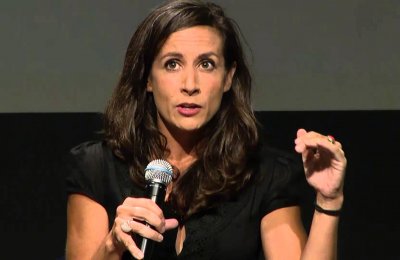For USC Annenberg student Chase Peterson (B.A. Communication ‘16), taking professor Alison Trope’s COMM 494: Critical Media Literacy, Research, and Service Learning class last year was the highlight of his undergraduate career.
He remembers talking to high school students from South L.A.’s Community and Technology School (CATS) about music videos, television and the #OscarsSoWhite controversy, and working with them to ask questions about the media they watch and read.
“We started the semester teaching them ‘this is what you see on TV; let’s break it down and try to understand everything being said here,’” Peterson recalled. “It’s really about opening the students’ eyes to the deeper meanings lurking within media. We want them to step back and realize that the influences behind the camera affect what you see on screen.”
Peterson was part of a pilot program between Trope’s class and CATS last fall centered around the Critical Media Project. Trope, clinical professor of communication and director of Undergraduate Studies, developed the COMM 494 course as a way for students to engage with local high school students and apply what they’ve learned at Annenberg by teaching media literacy.
Students from Trope’s COMM 494 visited CATS teacher Enrique Legaspi’s class several times, teaching a mix of ninth, tenth, 11th graders and seniors. At the end of the semester, the high school students came to USC for a final media lesson led by professor Trope, a question and answer session with USC students about college life, followed by a tour of USC and Annenberg.
Last year, Trope’s class was embedded with Legaspi’s Ethnic Studies classes. This year they’re working with his Digital Imaging class, which focuses on identity and how students use digital imagery to construct their identity.
Legaspi called the relationship a “great fit.”
“Last year, the class focused on creating videos, writing autobiographies,” Legaspi said. “This year we are looking to do more artwork, more multimedia, 3D printing. But, we are integrating the Critical Media Project principles.”
The interactions with the USC students give his students new perspectives and a better understanding of their own identities, Legaspi said.
“They can be more proud of their family background and become more comfortable with being vulnerable. They reflect on their own biases and what they have access to, on who has privilege and what that means,” Legaspi said.
COMM 494 is just part of Trope’s ongoing work with Critical Media Project (CMP), a research initiative and free website that helps high school instructors incorporate media literacy into the classroom. She launched the site in 2013, and it features a trove of media literacy-related classroom activities and lesson plans that incorporate images from advertisements and streamable media such as movies, television, music videos and online content. These resources raise critical awareness around media representations of race, ethnicity, gender, sexuality, and socio-economic class, and give teachers and their students the tools to decode the media around them, tell their own stories, and create their own representations.
The website, which includes more than 300 media examples, is a powerful tool for high school students trying to figure out their own identities and make sense of other identities regularly seen in the media they view, Trope said.
“I see the site and this kind of identity-driven media literacy as a potential antidote to the rampant phobias (xenophobia, racism, homophobia, misogyny), implicit and explicit bias, intolerance and hatred, that have been the root cause of so many recent social and political struggles,” Trope said. “I’d like to reach out to as many schools as I can, but especially those neighboring USC in the South L.A. area.”
In order to expand both the reach of the website and COMM 494’s presence in other schools, Trope is seeking grant funding to further the Critical Media Project’s mission with teachers and schools in underserved L.A. communities.
Trope recently received a grant from the Audrey and Sydney Irmas Charitable Foundation, which she plans to use to expand the website and organize a training workshop for Los Angeles Unified School District teachers at Annenberg next summer.

“We will discuss CMP’s relation to the Common Core, demonstrate how CMP can work in particular types of lessons, walk through the basic navigation and have teachers break into groups to workshop lesson plans and curriculum,” Trope said. “Enrique (Legaspi) will be there to highlight what he has done at CATS, and I hope to have some USC students as well as CATS students on hand to discuss their experiences.”
Trope also hopes to redesign the website to better highlight work currently featured on CMP’s classroom activities page, which can help students use media-making as a tool for awareness, empowerment, and action.
Live, on-site interactions will continue to be the heart of COMM 494.
“The Annenberg students loved interacting with these kids,” Trope said of taking her COMM 494 students out into the field. “They were very enthusiastic about having these interactions outside of the traditional classrooms. They really bonded.”
Hannah Cruz (B.A. Communication and American Studies ‘17) was glad she took Trope’s course, not just because she learned a lot by teaching students in the classroom, but because she also learned about herself.
“The Critical Media Project helps me think about identity politics and media literacy in more structural and more intersectional ways,” Cruz said. “I needed to think of my own presentation of self and how to make them comfortable on their presentation of self.”
Trope said she wanted more students to have an experience off campus, and soak in what South L.A. has to offer.
“Our students do many internships every year off campus. This partnership with CATS offers a unique opportunity for our students to engage with our local community and share what they’ve learned at Annenberg in another kind of real world setting,” Trope said.
For more information, please visit the Critical Media Project on its website and Facebook. Here is a link to last year’s Critical Media Project class work.






